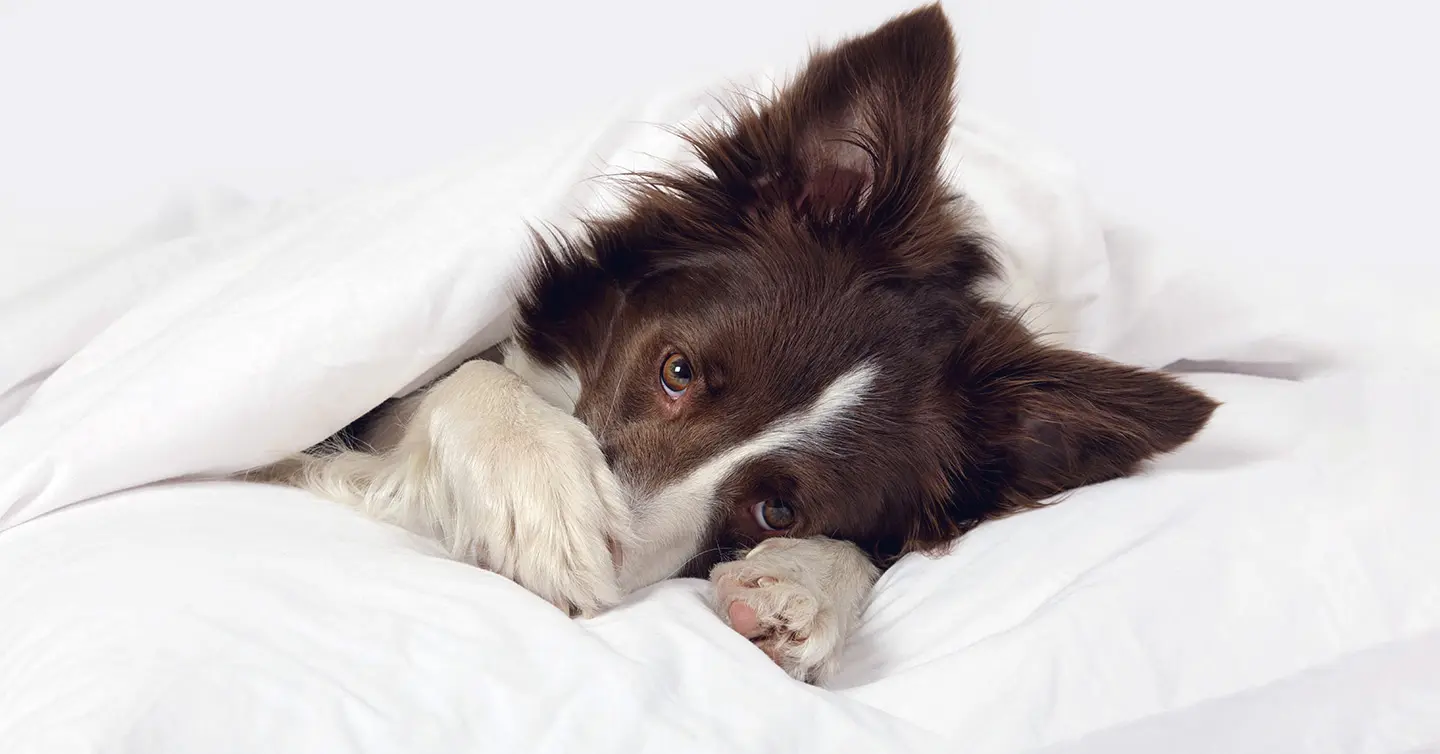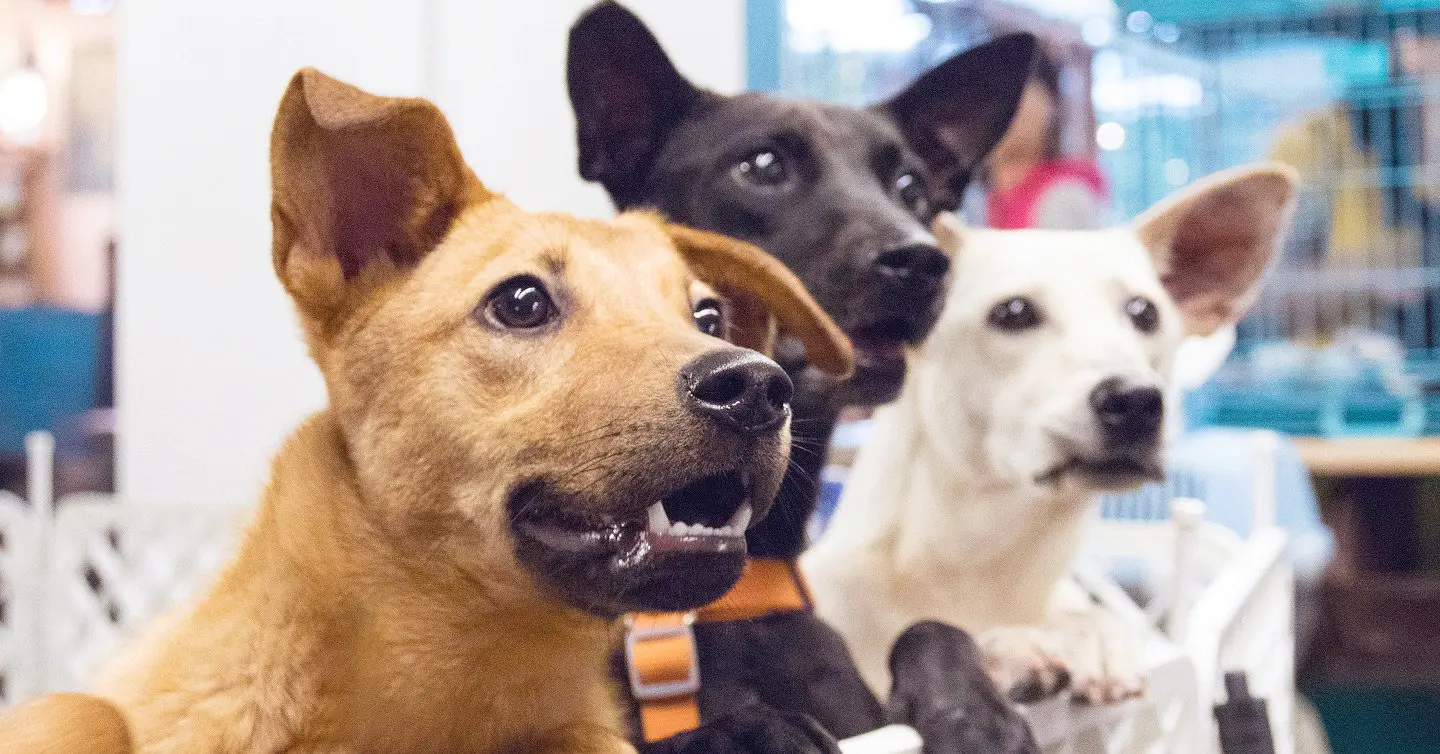Key Points
- Dogs can catch colds caused by viruses, but they aren’t transferable between humans and dogs.
- Sneezing, coughing, nasal discharge, watery eyes, mild fever, lethargy, and reduced appetite are common signs of a canine cold.
- Treatment includes hydration, rest, and humidifiers. Never give your dog any human cold medications.
If you’ve ever caught your pup sneezing or looking a little extra snugly under the blankets, you might wonder: Is my furry best friend coming down with something? Can dogs catch a cold?
While the viruses that cause the cold and flu in humans don’t affect our pooches, our pets fall victim to similar illnesses in the colder months. Just like us, our pups can experience sniffles, sneezes, and the occasional blah feeling.
This is especially common if your pet has recently come back from doggy daycare or an overnight dog boarding facility. Unfortunately, toddlers aren’t the only ones who pick up germs from their friends at sleepovers and daycare.
Here’s everything you need to know about dog colds, the symptoms to look out for, and how to help your pooch feel better.
Yes, dogs catch colds too
A dog cold is the canine version of a human cold, but they aren’t exactly the same. Dogs can fall victim to respiratory infections that bring on cold-like symptoms, including sneezing, coughing, and congestion. These infections are usually caused by viruses or bacteria that are specific to dogs, like canine parainfluenza or Bordetella (which you might know as kennel cough).
As with the common cold, a “dog cold” is typically mild, manageable, and not something to worry about. And because these doggie colds aren’t caused by the same viruses we get, your dog can’t catch a cold from you, and you can’t catch theirs. (Although, infections can spread between dogs, hence the danger of kennel cough.)
Most dog colds will pass with a little TLC. But it’s always a good idea to keep an eye on your furry friend in case the symptoms get worse or point to something more serious.
What causes colds in dogs?
Colds in dogs are caused by specific viruses and bacteria that affect their respiratory system. These are the most common culprits:
- Canine respiratory coronavirus: A virus similar to the human cold virus but specific to dogs.
- Canine adenovirus type 2: Often associated with respiratory infections in dogs.
- Canine parainfluenza virus: A major cause of infectious respiratory disease in dogs.
- Bordetella bronchiseptica: A bacterial infection that can mimic cold symptoms; also known as kennel cough.
- Canine influenza: Dogs can get the flu, although it’s not the same virus that causes you to get sick.
If you’re worried about your pup getting sick, ask your veterinarian about vaccinations. Vaccines are available for many common canine illnesses, but they may not be part of the standard core vaccines recommended for all dogs.
How do dogs catch colds?
Dogs catch colds through exposure to viruses and bacteria spread by other dogs. This can happen through:
- Direct contact: If an infected dog sneezes or coughs nearby, your pup can catch it. Likewise, dogs can spread germs by licking.
- Shared items: Germs can spread through shared toys, water bowls, or bedding.
- Contaminated environments: Places like kennels, dog parks, or groomers can be hot spots for spreading colds.
If your dog is sick, you may want to keep them away from other dogs until they’re no longer contagious.
Symptoms of dog colds
The symptoms of a dog cold can look a lot like what humans experience when they’re under the weather. Common signs include:
- Sneezing
- Coughing
- Watery eyes
- Runny nose
- Mild fever
- Lethargy
- Reduced appetite
How to treat your dog’s cold
Treating your dog’s cold is all about keeping them comfortable and helping them recover naturally. Here’s what you can do:
- Keep them hydrated. Make sure your pup has plenty of fresh water to drink.
- Let them rest. Just like us, dogs need extra rest to bounce back when they’re feeling under the weather.
- Use a humidifier. A humidifier can help ease stuffy noses and make breathing easier.
- Provide warmth and comfort. A cozy bed or blanket can go a long way in helping your dog feel better.
- Encourage light eating. If their appetite is low, try offering something gentle on their stomach, like plain boiled chicken or rice.
Most dog colds are mild, but keep an eye on their symptoms. If they seem to get worse or don’t improve in a few days, it’s time to call your vet.
Lastly, remember this: Never give your dog human cold medicine — it’s not safe for them. Painkillers like paracetamol and aspirin can be fatal for pets.
When to see a vet
Cold-like symptoms in dogs can also be signs of more serious illnesses. If you notice these signs, your pup should see a vet:
1. Symptoms persist beyond a few days
If your dog shows signs of a cold for more than 3-4 days without improvement, it’s time to consult a vet. This could indicate an underlying infection or a more serious issue. Even if it’s just a common infection like kennel cough, senior dogs and those with weak immune symptoms might need veterinary care.
2. Difficulty breathing
Wheezing, labored breathing, or heavy panting outside of normal exercise can indicate respiratory distress. If you notice your dog struggling to breathe normally, coughing, or they have blue gums, they require immediate veterinary care.
3. Nasal discharge changes
Clear nasal discharge is typical with mild colds, but if the discharge turns yellow, green, or bloody, it may suggest a bacterial infection or other complications.
4. Loss of appetite
If your dog stops eating or drinking, it can quickly lead to dehydration and weakened immunity. Lack of appetite is a red flag and warrants a vet visit.
5. Lethargy or weakness
Mild tiredness is normal when your pets are unwell, but severe lethargy or difficulty standing/moving points to something more serious. If your pup isn’t getting back on their feet, don’t hesitate to talk to your veterinarian, as they may require antibiotics or other emergency treatment.
6. High fever
Normal body temperature for dogs is about 99-102 degrees Fahrenheit (or 38-39 degrees Celsius). A fever higher than this indicates a problem and requires prompt veterinary care.
7. Coughing
Persistent or worsening coughs, especially those that sound like a “honking” noise, could indicate kennel cough, bronchitis, pneumonia, or even heart problems. In this case, take your sick pup to the vet.
8. Symptoms of other illnesses
Vomiting, diarrhea, or changes in urination along with cold symptoms suggest your dog might have an infection or systemic illness, requiring a vet visit. In this case, they may not have a cold at all.
Finally, remember that puppies, senior dogs, and dogs with compromised immune systems (such as diabetes or heart disease) are more vulnerable to complications and should see a vet at the first sign of illness.

Big red flags
If your dog is having trouble breathing, their gums look bluish, or they’re disoriented, don’t wait: head to the vet or an emergency clinic ASAP.
When in doubt, trust your gut. If your dog doesn’t seem like themselves or you’re feeling unsure, your vet’s there to help. Better safe than sorry, right?
Emergencies can happen at any time, and having a pet insurance plan in place means you don’t have to worry too much about cost when getting your pup the care they deserve. Find out how a Pumpkin Pet Insurance plan can help cover eligible vet bills for unexpected accidents or illnesses in the future.
Preventing colds in dogs
Let’s assume that your dog has already been vaccinated for common diseases. (They have been vaccinated, right?) Preventing colds in dogs is all about keeping their immune system strong and protecting them from environments where they might catch something. Here are some simple and practical tips to help keep your pup healthy and sniffle-free:
1. Keep their immune system strong
Feed your dog high-quality food that meets their nutritional needs. A strong immune system starts with good nutrition. Always make sure your dog has access to clean, fresh water. Keep them active with regular exercise but don’t overdo it, especially in extreme weather.
2. Avoid sudden temperature changes
Protect them from cold drafts or sudden weather shifts, especially in winter. Use a doggy sweater or coat if needed. Dry them off thoroughly after baths or wet outings to prevent chills.
3. Limit exposure to sick dogs
Avoid crowded places like dog parks or kennels if you know other dogs there are sick. Keep their vaccinations up to date to protect them against common canine illnesses like kennel cough or canine influenza.
4. Regular vet checkups
Routine visits to the vet can catch potential health issues early and ensure your dog stays in tip-top shape. Discuss preventive measures, like flu shots, if they’re prone to catching bugs.
5. Stay warm in cold weather
Unless you have a cold-weather dog breed, limit time outside when it’s freezing. Watch for signs of your dog getting too cold, like shivering or lifting their paws.
A little prevention goes a long way in keeping your dog healthy and happy. Thankfully, dog colds usually go away on their own. Mild colds usually clear up in a few days with proper rest and care.
FAQs
- https://pmc.ncbi.nlm.nih.gov/articles/PMC7132485/
- https://pubmed.ncbi.nlm.nih.gov/32369435/
- https://www.sciencedirect.com/topics/immunology-and-microbiology/canine-adenovirus-2
- https://www.merck-animal-health-usa.com/condition/canine-parainfluenza
- https://www.fergusonanimalhospital.com/site/blog/2024/04/30/parainfluenza-dogs
- https://vetmed.illinois.edu/pet-health-columns/keep-human-medications-away-from-pets/




